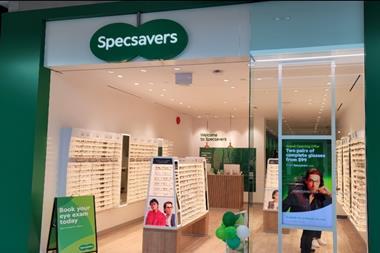There is not much good news on the retail park scene at the moment. But with the advent of the supermarket non-food formats, new life is being breathed into developments across the UK.
Asda opened the first of its non-food-only Asda Living stores in Walsall in October 2004 and now has 16 of them. Five more stores willopen this year – its biggest expansion drive to date. “This time last year we were trading nine Asda Living stores; now we will have 21 as we break into next year,” says Asda Living managing director Mike Logue. The retailer has identified the potential for 200 such stores. Logue admits the challenge is to find the right sites at the right price, but he is hoping for a similar rate of growth next year.
Tesco’s expansion of its non-food format, Tesco Homeplus, started a little later and slower. Its first store opened in Denton, Manchester, in late 2005 and the retailer presently has eight stores – its most recent opening being near Cribbs Causeway in Bristol. Two more will open before Christmas, in Edinburgh and Nottingham, and a site in Crewe is subject to planning approval. In this year’s annual report, Sir Terry Leahy said the retailer is committed to a chain of 17 Homeplus stores.
The retailers’ non-food formats vary in size. For Asda Living, the average is 20,000 sq ft (1,860 sq m), but the retailer also has a 15,000 sq ft (1,395 sq m) store in Wales and a 30,000 sq ft (2,790 sq m) store at Lakeside. Tesco, meanwhile, is going for larger units of about 30,000 sq ft (2,790 sq m) as standard. Both feature mezzanine floors.
Predominantly a homewares offering, the new formats are among a host of such fascias being rolled out on retail parks – including TK Maxx’s HomeSense and Home Retail Group’s Home Store + More, as well as more established formats such as Next Home and Bhs Home.
But the supermarkets undoubtedly have something of an edge with their new formats. “Asda Living and Tesco Homeplus have used their purchasing power and brand names to establish themselves in very key locations,” says Savills head of out-of-town retail Johnny Rowland, who has acted for landlords on a number of Asda Living and Tesco Homeplus deals.
Asda Living stores have been designed to showcase the non-food ranges available at its largest Asda food stores, including about 60 per cent dedicated to its George clothing range, as well as homewares, music and video, toys and baby products and a café offer.
The range is similar at Tesco, although it flexes the space devoted to each category according to the time of year, with product generally split with a quarter each for home, fashion and electricals, with toys, sports, seasonal and stationery making up the remainder of the product mix.
“The key is getting things out of the box – particularly those big-box general merchandise items such as paddling pools,” says Logue. “For that, Asda Living really works for us.”
Both concepts have evolved since their initial launch. “The Asda Living concept has proved to be very popular with our customers and since our first store opened in 2004, we have honed our offer to attract as wide a range of customers as possible,” explains Logue. “We have altered our store layout so that our George Clothing [which was previously upstairs] is on the ground floor.”
This simple flipping of the store has proved so successful at driving traffic that all existing and
new stores are now being laid out in the same way. “We have seen upwards of 20 per cent growth by leading with George so that is now the model for new stores,” says Logue. “It’s working for us because we are more famous for the George clothing brand.” Asda has also standardised its café offer and is putting additional focus on its baby shops in stores.
Softer Touch
Tesco’s format has changed as well. “Since launch we have increased the size of the stores to fit all our non-food range and made the environment less like grocery shopping, with more Direct product on display,” says a spokesman for the retailer.
Some of the previous Tesco sites have been accused of being too “hard”. “I think Asda Living has a better feel to it – Tesco looks a bit like a cheap and cheerful store,” says one property source.
However this seems to be a criticism that Tesco is now addressing. It has softened up the format for the Bristol Cribbs Causeway store opening – introducing bespoke fixtures and fittings so that the shop looks more like a department store than some of the preceding stores. The Cribbs Causeway store – the second Homeplus in Bristol – has also marked the introduction of an Argos-style collection desk and 10,000 sq ft (930 sq m) of additional warehouse space, allowing customers to take Tesco Direct products home immediately. The warehouse collection areas will be included in future Homeplus stores.
The new formats also bring supermarket prices to the retail parks. Jason Sibthorpe, director of retail at GVA Grimley, which is a retained agent for Asda Living, says the format is particularly suited to the current economic climate. “We are hopeful that the business will continue to show the robustness of other value retailers,” he says.
Footfall Boost
And they are huge footfall drivers. Asda opened its Leeds Crown Point store in September 2006 and saw footfall to the park rise by 5,000 visits a week. “The advantage on a park is effectively having a supermarket logo on site – that really does drive footfall,” says Rowland.
Wilkinson Williams partner James Potter, who has acted on behalf of landlords for a number of the Asda Living deals, says the stores’ greatest impact is in drawing both new customers and retailers to the park. He says: “At Tottenham Hale Retail Park, prior to Asda Living opening, the park used to attract circa 20,000 cars a week. But following Asda and Next opening, this increased to circa 32,000 cars a week.”
Subsequent openings by the likes of JD Sports and Boots and an aggressive local marketing campaign by the landlord, Hermes, boosted the numbers to nearly 50,000 cars a week, Potter says. “The benefits of Asda here are twofold, firstly in attracting additional footfall themselves but also in attracting other high street retailers that can benefit from being adjacent to them,” he explains.
And while Potter concedes not everyone may be jumping for joy at Asda Living’s arrival, it is generally a welcome addition. “There will be instances where other retailers may see sales fall among certain product lines because of the increased competition and aggressive pricing within Asda Living stores,” he says. “But on the whole, we believe other retailers are positive about the likes of Asda Living opening on retail parks because of the increased footfall it generates.”
Logue agrees. He says: “We prefer tenant line-ups to include complementary fashion and homeware retailers such as TK Maxx, Next and New Look, and non-fashion retailers such as Boots and Argos.”
British Land has opened Asda Livings at nine of its retail parks and a Tesco Homeplus at one. British Land head of retail Andrew Jones says the arrival of the formats is enabling a change of focus for traditional bulky goods retail parks. “It’s a transformational letting. If you are trying to soften a park, it works really well,” he adds.
Jones agrees that it helps draw in other players too. “We see them acting as mini anchors. The high street retailers feel very comfortable sitting next to Asda Living,” he says. “On the back of the Walsall opening [the first Asda Living] we did deals with HMV, Arcadia and Smyths Toys.”
The Asda Living and Tesco Homeplus formats also allow the landlords to sweat their space more effectively – as both are putting in mezzanine floors.
So will other supermarkets follow their lead or are Asda and Tesco set to further secure their grip on this developing market? Potter believes it is unlikely the two will face further competition. “At the moment it seems unlikely because Sainsbury’s seems keen to keep any non-food offer within its supermarkets, as it helps drive additional food sales and Morrisons and Waitrose only have minimal non-food offers,” he says.
Others suggest that the likes of Asda Living and Tesco Homeplus could go the other way and expand the concepts to include a mini food offer where space and food consents allow. “It’s very difficult to find areas of the UK that aren’t already well represented by food retailing but there are a lot of retail parks that have food consent on them and I could see such formats adding a top-up food area of 5,000 or 6,000 sq ft,” says Jones. “I would love it if they asked to have that space for food.”
Rowland believes this to be unlikely, though. “It would be sensible, yes, but I doubt it would be possible,” he says. “These are open A1 non-food parks and any food element must be ancillary to the main use, so no more than, say, 1,000 sq ft. If you are starting to get serious about food you have to have planning for it.”
Rupert Thornton, director at Atisreal, joint retained agents for Asda Living, says landlords welcome Asda Living onto their parks, usually creating space for them rather than giving them redundant space.“The deals we do don’t normally involve empty units,” he says. “Landlords positively want to put us into their schemes. Generally speaking, these deals are impossible to do unless the landlord wants us there because we are taking the space that generally a bulky goods retailer might have taken.”
Thornton believes the formats have a key role to play. “It’s a commercial opportunity that is welcomed because it’s giving the variety that the parks need to sustain shopper interest,” he says.
For retail parks that have suffered of late, it seems there really is no place like home


























No comments yet